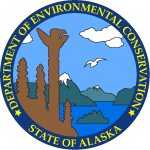| Action Date |
Action |
Description |
DEC Staff |
| 2/13/1999 |
Cleanup Plan Approved |
Leslie Pearson from Spill Response Unit met with the Air Force and agreed on a response plan to the Spur Road surface spill. Spill team would continue operations to remove all impacted snow to a heated facility to extract and dispose of the fuel. The team would remove all possible free phase fuel from the impacted surface area and clean area with sorbent material. Once the non-paved areas were cleaned, they would be covered with a liner to prevent inhalation and ingestion risk (18 AAC 75 ingestion/inhalation levels DRO: 10,250/12,500 mg/kg, GRO: 1400, RRO 10,000/22,000 mg/kg). At some time in the future, the impacted soil would be removed, stockpiled for treatment and clean soil be returned to the excavation. Because of the frozen ground, this volume is expected to be minimal. The frozen ground appears to have prevented any significant infiltration into the subsurface and no sources of subsurface conduit have been identified. |
Louis Howard |
| 2/13/1999 |
Update or Other Action |
Spill report form sent to Leslie Pearson and Central AK Response Team from the Air Force. JP-8 jet fuel spilled and they are collecting snow to melt and recover the spilled fuel. Spill # assigned by PERP was 99239904402. |
Louis Howard |
| 4/9/1999 |
Update or Other Action |
Memorandum for ADEC from Air Force re: Spur Road JP-8 Fuel Release. On 2/13/1999, at 0615 hours, an R-11 refueling tanker had a universal joint failure causing the drive shaft to strike the main fuel line resulting in a release of 1700 gallons of JP-8. Release occurred at Spur Road 200 yards north of the intersection with Second Street. Soil underlying the impacted surface area was excavated to a depth of 3 to 6 feet bgs over the entire area of the visible surface expression. 72 cubic yards of soil was excavated and placed in the long-term POL stockpile at the Base Central Stockpiling area. Depth to groundwater is approximately 27 feet bgs and groundwater flow is to the southwest. Downgradient monitoring wells: OU5MW-07, OU5MW-08, and OU5MW-33 are monitored on semi-annual intervals. |
Louis Howard |
| 7/26/1999 |
Update or Other Action |
Gail Volt approved request from Air Force to transport POL Contaminated soil for thermal treatment and disposal. Nine 55-gallon drums and approximately 72 cubic yards of POL contaminated soil in stockpile from excavations at SS807. User knowledge statement and summary of PID readings and grab sample analytical results for the subject soils is attached. Based on that information, EAFB proposes to transport soil to ASR for treatment and disposal. |
Gail Volt |
| 9/13/1999 |
Update or Other Action |
Frank Wesser granted approval to transport POL contaminated soils generated from SS807 spill. Nine 55-gallon drums of POL contaminated soil excavated from the Spur Road site (spill# 99239904402). |
Louis Howard |
| 5/31/2000 |
Update or Other Action |
SERA Phase VIII Release Investigation Report SS807 Spur Road release final version received. SS807 is the location of a surface spill adjacent to Talley Avenue (formerly Spur Road), approximately 200 yards north of the intersection with Arctic Warrior Drive. In February of 1999, a refueling tanker experienced a mechanical failure on Talley Avenue. Approximately 1,776 gallons of jet propulsion fuel (JP-8) was released and flowed to the west of the road surface into a narrow depression that paralleled the road. (NOTE: JP-8 fuel, also designated as NATO F-34,
is similar to Jet A-1 and is the primary fuel
used by the U.S. Air Force and the U.S.
Army. Improved fire safety was a major
reason the Air Force converted from JP-4
to JP-8. A number of additives, including
an antistatic additive, an icing inhibitor,
and a corrosion inhibitor, have been
approved by the U.S. Air Force.) This product flowed south within this depression approximately 215 feet. The width of the visible surface product was approximately 2 to 3 feet wide.
During the State-Elmendorf Environmental Restoration Agreement (SERA) Phase VIII investigation in October of 1999, four borings and one monitoring well were installed at the site. Only DRO exceeded the 18 AAC 75, Method Two cleanup level (250 mg/kg) with a maximum concentration of 600 mg/kg. The benzene laboratory reporting limit was 0.05 mg/kg and the method detection limit was 0.02 mg/kg.
One groundwater sample was collected from well 807WL01 and analyzed for GRO, DRO, BTEX, and PAHs. All constituent results were non-detectable or detected below the 18 AAC 75, Table C groundwater cleanup levels. |
Louis Howard |
| 2/21/2001 |
Update or Other Action |
Staff approved the Air Force's Request for Closure, SERA Phase VIII SS807 Release Investigation Report Spur Road Release Final dated May 2000. Based on the data presented in the report, it appears the area is not be impacted with sufficient product to cause significant subsurface leaching nor was there any indication that surface or subsurface water could be impacted. The release occurred in an area where ground water contamination levels are being regularly monitored on a long-term basis with monitoring wells directly down gradient from the area of release. In view of the nature of the spill, the Air Force’s excavation and recovery efforts, the low probability for groundwater involvement, and the ongoing water monitoring in the area, ADEC will not require any additional remedial action be taken with this specific release. The site will be designated a “no further remedial action” site in the CS Database.
No further assessment or remediation of the site is requested by ADEC at this time based upon the data submitted by the Air Force. However, this decision does not preclude future remediation or site investigation if new information indicates there is previously undiscovered contamination or exposures, which cause unacceptable risk to human health, safety, or welfare, or the environment. Future investigation and/or remedial actions may be required if contamination exceeding these risks is detected or if the contamination is excavated for any reason. ADEC reserves all of its rights under Title 46 of Alaska Statutes and 18 AAC 75 to request additional activities in the future if necessary to address these risks. The Air Force must maintain institutional controls on the site to limit access to the soils. If the soils are excavated or removed from the site, they must be properly handled and the contaminated soil disposed of at a permitted facility. |
Louis Howard |
| 6/10/2004 |
Conditional Closure Approved |
On April 26, 2004, the Alaska Department of Environmental Conservation (the Department) received several decision document packets. Among them was a packet for ST419 AFID 51 and 52, SS807 Refueler Tanker Truck site. They included: a site history summary, site characterization and cleanup work conducted to date along with a request for No Further Action (NFA). A NFA decision for SS807 at Talley Avenue has already been granted (see enclosure).
ADEC has calculated a cleanup matrix score and determined that level “C” cleanup level is appropriate for SS807: 500 mg/kg GRO and 1,000 mg/kg DRO. 600 mg/kg DRO was detected in soil at 10' in one boring. No groundwater impacts were observed from the well installed at the site so Method One is applicable. ADEC will grant site closure for SS807. It is recommended that monitoring well 807WL01 installed for SS807 be decommissioned as soon as possible unless the Air Force has another reason for it to be monitored.
The Department reserves its rights, under: 18 AAC 75 Contaminated Site regulations and AS 46.03 to require additional investigation, cleanup, or containment if subsequent information indicates: additional contamination remains at the site which was previously undiscovered and presents an unacceptable risk to human health, safety, or welfare, or the environment.
The following policy applies for soil regulated under 18 AAC 75 and 18 AAC 78 that is proposed for disposal off site from where it was generated. If the following criteria is met, ADEC approval and/or an institutional control(s) are not required:
1. The soil meets the most stringent Method Two, Migration to Groundwater, Table B2 cleanup level, and the most stringent standards for those chemicals under Table B1;
2. The soil may only be disposed of at any non-environmentally sensitive location in the Under 40" or Over 40" annual precipitation zone;
3. The soil is not placed within 100 feet of water wells, surface waters, and drainage ditches; and
4.The written approval from the landowner of the off-site location is required.
The off site disposal of all other soil subject to the site cleanup rules that does not meet the criteria above shall be reviewed by the ADEC project manager in order to determine if the off-site disposal action poses a current or future risk to human health or the environment. The final approval to dispose of soil off site that does not meet the criteria shall be made by the ADEC.
Terms used in this document have the meaning given in 18 AAC 75.990 including: “environmentally sensitive area” means a geographic area that, in the department's determination, is especially sensitive to change or alteration, including:
(A) an area of unique, scarce, fragile, or vulnerable natural habitat;
(B) an area of high natural productivity or essential habitat for living organisms;
(C) an area of unique geologic or topographic significance that is susceptible to a discharge;
(D) an area needed to protect, maintain, or replenish land or resources, including floodplains, aquifer recharge areas, beaches, and offshore sand deposits;
(E) a state or federal critical habitat, refuge, park, wilderness area, or other designated park, refuge, or preserve; and
(F) an area that merits special attention as defined at 6 AAC 80.170 (Repealed see AS 46.40.210(1))
“area which merits special attention” means a delineated geographic area within the coastal area which is sensitive to change or alteration and which, because of plans or commitments or because a claim on the resources within the area delineated would preclude subsequent use of the resources to a conflicting or incompatible use, warrants special management attention, or which, because of its value to the general public, should be identified for current or future planning, protection, or acquisition; these areas, subject to council definition of criteria for their identification, include:
(A) areas of unique, scarce, fragile or vulnerable natural habitat, cultural value, historical significance, or scenic importance;
(B) areas of high natural productivity or essential habitat for living resources;
(C) areas of substantial recreational value or opportunity;
(D) areas where development of facilities is dependent upon the utilization of, or access to, coastal water;
(E) areas of unique geologic or topographic significance which are susceptible to industrial or commercial development;
(F) areas of significant hazard due to storms, slides, floods, erosion, or settlement; and
(G) areas needed to protect, maintain, or replenish coastal land or resources, including coastal flood plains, aquifer recharge areas, beaches, and offshore sand deposits. |
Louis Howard |
| 6/10/2004 |
Institutional Control Record Established |
Since soil contamination is above the most stringent found in 18 AAC 75.341 Method Two at 600 mg/kg (cleanup level is 250 mg/kg), the Air Force must maintain institutional controls on the site to limit access to the soils. If the soils are excavated or removed from the site, they must be properly handled and the contaminated soil disposed of at a permitted facility. |
Louis Howard |
| 6/14/2004 |
Site Added to Database |
DRO. |
Sarah Cunningham |
| 6/22/2004 |
GIS Position Updated |
Established rough latitude and longitude based on description of spill in relation to streets. NAD27. |
Former Staff |
| 12/5/2007 |
Update or Other Action |
Staff commented on the Site Closure Confirmation Request, Environmental Compliance Program, Elmendorf AFB, Alaska dated November 6, 2007 for twenty-three (23) sites submitted by the Air Force’s Environmental Compliance Program. This request was to confirm the sites have met all applicable State of Alaska cleanup regulations.
ADEC still concurs no further remedial action is warranted at SS807. However, diesel range organic (DRO) contamination is present at levels as high as 600 mg/kg at 10’ bgs ( See SERA VIII Release Investigation Report SS807 Table 3-1 SS807 Subsurface Soil Sample Analytical Results May 2000). This does exceed ADEC’s most stringent cleanup levels in 18 AAC 75.341 Table B2. Method Two Under 40” Zone – Petroleum Hydrocarbon Soil Cleanup Levels (as amended through December 30, 2006). The site will be assigned a “Conditional Closure” action in our contaminated sites database. Soil containing residual contamination may not be placed in surface water or other environmentally sensitive areas. Please note, per 18 AAC 75.325(i), ADEC approval is required prior to disposing of soil or water from a site that is, or has been, subject to the site cleanup rules. A “Site Closure Approved” action will be entered if, and when, it is demonstrated to meet the most stringent cleanup level 250 mg/kg migration to groundwater for Under 40” zone.
ADEC is basing its decision on the most current and complete data provided by the Air Force. ADEC reserves its rights, under: 18 AAC 75 Oil and Other Hazardous Substances Pollution Control regulations and Alaska Statute 46.03 to require additional investigation, cleanup, or containment, if subsequent information indicates that: additional contamination remains at the site which was previously undiscovered and presents an unacceptable risk to human health, safety, or welfare, or the environment. Please note, per 18 AAC 75.325(i), department approval is required prior to disposing of soil or water from a site that is, or has been, subject to the site cleanup rules. |
Louis Howard |
| 6/10/2013 |
Exposure Tracking Model Ranking |
Initial ranking with ETM completed for source area id: 74145 name: auto-generated pm edit Elmendorf SS807 Tanker Spill |
Louis Howard |




